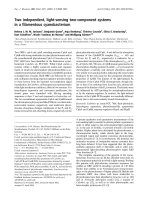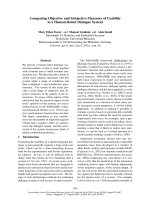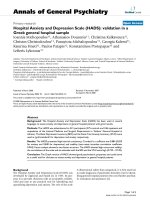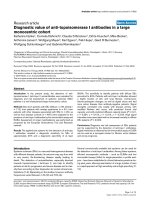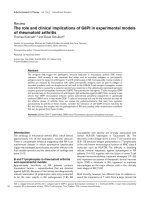Báo cáo y học: "Hospital Anxiety and Depression Scale (HADS): validation in a Greek general hospital sample" pdf
Bạn đang xem bản rút gọn của tài liệu. Xem và tải ngay bản đầy đủ của tài liệu tại đây (219.27 KB, 5 trang )
BioMed Central
Page 1 of 5
(page number not for citation purposes)
Annals of General Psychiatry
Open Access
Primary research
Hospital Anxiety and Depression Scale (HADS): validation in a
Greek general hospital sample
Ioannis Michopoulos
†1
, Athanasios Douzenis
†1
, Christina Kalkavoura
†1
,
Christos Christodoulou
†1
, Panayiota Michalopoulou
†1
, Georgia Kalemi
†1
,
Katerina Fineti
†1
, Paulos Patapis
†2
, Konstantinos Protopapas
†3
and
Lefteris Lykouras*
1
Address:
1
Second Department of Psychiatry, Athens University Medical School, 'Attikon' General Hospital, Athens, Greece,
2
Third Department of
Surgery, University of Athens, School of Medicine, 'Attikon' University Hospital, Athens, Greece and
3
Fourth Department of Internal Medicine,
University General Hospital 'Attikon', Athens, Greece
Email: Ioannis Michopoulos - ; Athanasios Douzenis - ;
Christina Kalkavoura - ; Christos Christodoulou - ;
Panayiota Michalopoulou - ; Georgia Kalemi - ; Katerina Fineti - ;
Paulos Patapis - ; Konstantinos Protopapas - ;
Lefteris Lykouras* -
* Corresponding author †Equal contributors
Abstract
Background: The Hospital Anxiety and Depression Scale (HADS) has been used in several
languages to assess anxiety and depression in general hospital patients with good results.
Methods: The HADS was administered to 521 participants (275 controls and 246 inpatients and
outpatients of the Internal Medicine and Surgical Departments in 'Attikon' General Hospital in
Athens). The Beck Depression Inventory (BDI) and the State-Trait Anxiety Inventory (STAI) were
used as 'gold standards' for depression and anxiety respectively.
Results: The HADS presented high internal consistency; Cronbach's α cofficient was 0.884 (0.829
for anxiety and 0.840 for depression) and stability (test-retest intraclass correlation coefficient
0.944). Factor analysis showed a two-factor structure. The HADS showed high concurrent validity;
the correlations of the scale and its subscales with the BDI and the STAI were high (0.722 – 0.749).
Conclusion: The Greek version of HADS showed good psychometric properties and could serve
as a useful tool for clinicians to assess anxiety and depression in general hospital patients.
Background
The Hospital Anxiety and Depression Scale (HADS) was
developed by Zigmond and Snaith [1] in 1983. Its pur-
pose is to provide clinicians with an acceptable, reliable,
valid and easy to use practical tool for identifying and
quantifying depression and anxiety. The role of the scale
is dimensional rather than categorical; it is best used not
to make diagnoses of psychiatric disorders, but for identi-
fying general hospital patients who need further psychiat-
ric evaluation and assistance [2].
Published: 6 March 2008
Annals of General Psychiatry 2008, 7:4 doi:10.1186/1744-859X-7-4
Received: 7 November 2007
Accepted: 6 March 2008
This article is available from: />© 2008 Michopoulos et al; licensee BioMed Central Ltd.
This is an Open Access article distributed under the terms of the Creative Commons Attribution License ( />),
which permits unrestricted use, distribution, and reproduction in any medium, provided the original work is properly cited.
Annals of General Psychiatry 2008, 7:4 />Page 2 of 5
(page number not for citation purposes)
Depression and anxiety among general hospital patients
could be much higher than is generally assumed, com-
pounding the basic medical condition prognosis. The
prevalence of depression in medical and surgical inpa-
tients in Greece, using the Beck Depression Inventory
(BDI) [3], was found to be 29% [4]. Proportional findings
also include cancer patients (20–25%) [5]. Not only gen-
eral hospital patients, but also cancer patients have
reported that they might benefit from specific interven-
tions aimed at psychological symptoms [6].
The HADS has been translated and widely used in more
than 25 countries since its original development [2]. Her-
rmann, in an extended review, reported that the HADS
has demonstrated reliability and validity when used to
assess medical patients [2]. Bjelland reached similar con-
clusions in his review 5 years later [7]. The HADS has been
used in the general population [8-10], on general hospital
patients [11-14], in cancer care settings [15-17], and even
in HIV patients [18]. The HADS has been translated into
Greek and validated in a palliative care unit for cancer
patients with good results [19].
The aim of this study was to validate the Greek translation
of the HADS, and assess its psychometric properties in
general hospital patients.
Methods
Subjects
The study was performed by the Second Department of
Psychiatry at the 'Attikon' General Hospital in Athens.
Three groups participated; one group of elderly inpatients
in the Internal Medicine and Surgical Departments, one
group of outpatients waiting to be examined in the Inter-
nal Medicine Outpatients Department and one general
population group which was assessed by mail (this group
is referred to as 'controls'). A total of 521 participants
completed the study; 246 patients and 275 controls.
Instruments
The HADS is a self-report rating scale of 14 items on a 4-
point Likert scale (range 0–3). It is designed to measure
anxiety and depression (7 items for each subscale). The
total score is the sum of the 14 items, and for each sub-
scale the score is the sum of the respective seven items
(ranging from 0–21). It is worth noting that items refer-
ring to depression symptoms that describe somatic
aspects of depression (e.g. insomnia and weight loss) are
not included in the scale. The Greek translation by 'nFer
Nelson Publishing' (The Chiswick Centre, 414 Chiswick
High Road, London, UK) was used with permission.
The Beck Depression Inventory (BDI) was used to meas-
ure depression. It is designed to examine both somatic
and cognitive aspects of depression. The BDI is a 21-item
self-reporting scale that has been used, apart from its orig-
inal purpose (assessment of the severity of known depres-
sion), for screening purposes. The Greek version has been
translated and validated previously [20] and has been
widely used to date.
The State-Trait Anxiety Inventory (STAI)[21] developed by
Spielberger is used to measure anxiety. It is a 40-item scale
made up of two 20-item subscales (one state and one
trait), and has been widely used to asses anxiety not only
in clinical but in non-clinical samples. The STAI (Form X)
has been translated and validated in Greek [22]. The BDI
and STAI were administered to patients only.
All of the scales used are self-rated and were administered
by five of the researchers. The aim was that the examiners
would interfere as little as possible in the patient's com-
pletion of the scales. For homogeneity of the results, the
scoring of the scales was performed by only one of the
researchers.
Statistical analysis
The following tests were used for the statistical analysis of
the data: the Pearson Chi-square test was used for compar-
ison of percentages, and thee Student t test and one-way
analysis of variance (ANOVA, with Bonferroni correction)
for comparison of means of variables. Correlations were
tested by the Pearson r or the Spearman r
s
coefficients,
depending on whether the variables were normally dis-
tributed or not. The psychometric properties of the HADS
were evaluated by the following: construct validity was
assessed by inter-item and inter-scale correlations and
exploratory factor analysis (principal components with
varimax rotation). The intraclass correlation coefficient
was used to explore the test-retest reliability. The internal
consistency of the scale was calculated with Cronbach's
alpha coefficient (minimum acceptable value for alpha
was 0.7). Concurrent validity was assessed by calculating
correlations between the HADS and the BDI (the gold
standard for depression) and the STAI (the gold standard
for anxiety). Statistical analysis was carried out using SPSS
(Version 11.0) for Windows (SPSS Inc., Chicago, IL, USA).
Results
Patient characteristics
The demographic data for the participants are listed in
Table 1. The patients group consisted of two subgroups:
150 inpatients (elderly inpatients of age > 65 years attend-
ing the Internal Medicine and Surgical Departments) and
96 outpatients of all ages waiting to be examined in the
Internal Medicine Outpatients Department. The differ-
ences in age and sex among the three groups were of sta-
tistical significance.
Annals of General Psychiatry 2008, 7:4 />Page 3 of 5
(page number not for citation purposes)
The mean scores for HADS, BDI and STAI are listed in
Table 2. Comparing patients as a whole to the controls (t
test) showed that patients had greater values as assessed
by HADS, HADS-D (depression) and HADS-A (anxiety)
with a level of statistical significance p < 0.001. The same
finding was generally observed when inpatients and out-
patients were compared to controls separately and to each
other (using ANOVA after Bonferroni correction); inpa-
tients and outpatients showed higher scores than controls.
It is worth noting that although inpatients and outpa-
tients had similar scores on the HADS-D, outpatients
showed higher scores on the HADS-A.
Zigmond and Snaith [1] have suggested two cut-off scores
for detecting depression and anxiety that have generally
been used in most studies; scores of 8 to 10 = doubtful
cases, and scores of 11 and higher = valid cases. Bjelland
et al., in their review, report that most studies conclude the
cut-off score of 8 in general population and in somatic
patients samples is correct [7]. The same score has been
recently proposed by Olsson et al. for outpatients [23]. In
our patient sample (inpatients and outpatients), the prev-
alence of doubtful cases was 14.2% for depression and
16.3% for anxiety. The prevalence of valid cases was
13.4% for depression and 15.1% for anxiety. These per-
centages for patients only were 22.3% for doubtful cases
for depression and 17.4% for anxiety and 22.7% for valid
cases for depression and 21.9% for anxiety.
Psychometric properties of HADS
Internal consistency
The HADS Cronbach's α value for the total HADS was
0.884, for anxiety 0.829 and for depression 0.840. Con-
struct validity measured by item-scale correlations ranged
from 0.540 to 0.804 and were always higher for each item
with its factor (anxiety or depression). For details see
Table 3.
Test-retest reliability
Fifty of the controls, randomly selected, completed the
HADS on two occasions with a 20-day interval. Both the
total scale and the two subscales showed high retest stabil-
ity. The intraclass correlation coefficient for the total
HADS was 0.944, for the HADS/anxiety 0.899 and for the
HADS/depression 0.837. None of the scales showed sta-
tistically significant differences between test and retest.
Factor analysis
The HADS has a two-factor structure; factor I for depres-
sion and factor II for anxiety. All items, with the exception
of item 14 (detecting depression), showed higher scores
for the factor they were expected to. The factor loadings
are shown in Table 4.
The correlation between the anxiety factor II of the HADS
and the STAI (state) was 0.628 (p < 0.001) and the corre-
lation between depression factor I of the HADS and the
BDI was 0.661 (p < 0.001). Correlations between the sub-
scales: HADS/anxiety with HADS/depression: 0.559.
Concurrent validity
The BDI and STAI were used as gold standards to assess
depression and anxiety correspondingly. The correlations
between the BDI and STAI and the total HADS were high;
BDI: 0.749, STAI (state): 0.758. The correlation between
the HADS/anxiety and STAI (state) was 0.774, and
between the HADS/depression and BDI: 0.722 (p <
0.001).
Discussion
In the present study, the HADS was tested on a sample of
Greek general hospital patients (inpatients and outpa-
Table 1: Participant emographic data
Group Number Age (SD) Sex (% male)
Patients 246 64.68 (17.15) 46.3
Inpatients 150 74.14 (7.21)* 54.7 †
Outpatients 96 49.90 (17.74)* 33.3 †
Controls 275 37.11 (7.62)* 59.3 †
Total 521 50.13 (18.94) 53.2
ANOVA, analysis of variance; SD, standard deviation.
*p < 0.01 by ANOVA, **p < 0.01 by Pearson Chi-squared.
Table 2: Patient psychometric data
Group HADS HADS depression HADS anxiety BDI STAI state STAI trait
Patients (Inpatients + Outpatients) 14.0 (7.9)* 7.3 (4.4)* 6.6 (4.5)* 12.3 (8.4) 43.1 (12.7) 38.5 (11.6)
Inpatients 12.6 (7.9)† 7.3 (4.7) 5.2 (4.2) 10.8 (7.2) 40.4 (12.3) 34.0 (9.4)
Outpatients 16.1 (7.4)† 7.3 (3.8) 8.7 (4.3)† 14.7 (9.5) 48.0 (12.1) 46.7 (10.9)
Controls 9.1 (6.1)*† 3.9 (3.1)*† 5.1 (3.7)*
Total 11.4 (7.4) 5.5 (4.1) 5.8 (4.2)
ANOVA, analysis of variance; BDI, Beck Depression Inventory; HADS, Hospital Anxiety and Depression Scale; STAI, State-Trait Anxiety Inventory.
*p < 0.001 in t test patients vs controls; † p < 0.001 in ANOVA inpatients vs outpatients vs controls.
Annals of General Psychiatry 2008, 7:4 />Page 4 of 5
(page number not for citation purposes)
tients), and controls from the community. The HADS
appears to have high internal consistency; Cronbach's α
value for the total HADS was 0.884.
The Greek version of the HADS seems to be bidimen-
sional; thus, it could be considered that the two subscales
of the HADS measure anxiety and depression independ-
ently. The HADS and its two subscales showed high corre-
lations with the gold standards that were used to measure
depression (BDI) and anxiety (STAI).
As expected, patients in general appeared to be more
depressed and anxious than the subjects from the general
population (controls). Outpatients seemed to be more
affected than inpatients in presenting anxiety. This could
be attributed to the outpatients' concern about hearing
bad news as a result of their consultation. By contrast,
inpatients are in a way settled in the 'safety' of the ward.
The psychometric properties of the G reek version of the
HADS are similar with those of other languages [8,9,12-
14]. The HADS generally appears to have a high internal
consistency; Cronbach's α values ranged from 0.870 to
0.885 for all the items of the scale. The item-subscale cor-
relations were moderate to high; from 0.608 to 0.762 for
the anxiety items, and from 0.540 to 0.804 for the depres-
sion items. The HADS appears to be bidimensional as in
the original study by Zigmond and Snaith [1]. All items
but one (item 14) loaded in the appropriate factor. Simi-
lar findings for one or two, but not always the same, items
have been reported not loading to the appropriate factor
in many other studies. Most studies report the two factor
structure of the HADS [2,7], though there are some excep-
tions that have reported one factor [16], or three
[10,17,24], or even four factors [17]. The study of Mykle-
tun et al. with 51,930 participants, which is the largest of
all in the literature, concluded a bidimensional structure
for the HADS was correct [9].
The HADS property of consisting of two independent sub-
scales can also be shown by its correlations with the scales
that were used as gold standards for depression and anxi-
ety. The HADS/anxiety correlated highly with the STAI
and the HADS/depression correlated highly with the BDI.
There are some studies where the total HADS showed
greater correlations than its subscales with BDI and STAI
correspondingly [8,12,16,25], but in our study the total
HADS correlated to almost the same levels as its corre-
sponding subscales with BDI and STAI (a little higher than
HADS/depression with BDI, and a little lower than
HADS/anxiety with STAI). It is worth noting that the two
HADS subscales had a moderate correlation (0.559) to
each other. This could be expected, bearing in mind that
Table 4: Factor loadings (n = 521)
HADS items Factor 1 (depression) Factor 2 (anxiety)
1 (anxiety) 0.466 0.528
2 (depression) 0.742 0.188
3 (anxiety) 0.192 0.712
4 (depression) 0.725 0.245
5 (anxiety) 0.365 0.645
6 (depression) 0.761 0.307
7 (anxiety) 0.311 0.623
8 (depression) 0.679 0.275
9 (anxiety) 0.440 0.547
10 (depression) 0.702 -3.79E-02
11 (anxiety) -5.17E-02 0.706
12 (depression) 0.752 0.166
13 (anxiety) 7.875E-02 0.772
14 (depression) 0.346 0.360
Extraction method: principal component analysis; rotation method:
varimax with Kaiser normalisation. HADS, Hospital Anxiety and
Depression Scale, bold: greater values of factor loadings in every item.
Table 3: Item-scale correlations and Cronbach's α value
HADS items HADS HADS depression HADS anxiety Cronbach's α (if item deleted) for the total HADS
1 (anxiety) 0.696 0.521 0.719 0.873
2 (depression) 0.661 0.748 0.434 0.875
3 (anxiety) 0.625 0.372 0.743 0.877
4 (depression) 0.691 0.765 0.469 0.873
5 (anxiety) 0.699 0.484 0.762 0.873
6 (depression) 0.755 0.804 0.544 0.870
7 (anxiety) 0.645 0.459 0.687 0.875
8 (depression) 0.679 0.720 0.493 0.874
9 (anxiety) 0.688 0.521 0.705 0.873
10 (depression) 0.519 0.665 0.261 0.884
11 (anxiety) 0.462 0.215 0.608 0.885
12 (depression) 0.669 0.782 0.415 0.874
13 (anxiety) 0.582 0.333 0.702 0.878
14 (depression) 0.513 0.540 0.375 0.882
HADS, Hospital Anxiety and Depression Scale, bold: greater values in item-scale correlations.
Publish with BioMed Central and every
scientist can read your work free of charge
"BioMed Central will be the most significant development for
disseminating the results of biomedical research in our lifetime."
Sir Paul Nurse, Cancer Research UK
Your research papers will be:
available free of charge to the entire biomedical community
peer reviewed and published immediately upon acceptance
cited in PubMed and archived on PubMed Central
yours — you keep the copyright
Submit your manuscript here:
/>BioMedcentral
Annals of General Psychiatry 2008, 7:4 />Page 5 of 5
(page number not for citation purposes)
depression and anxiety show great comorbidity, especially
in general health care settings [26].
There are some limitations in our study; there were gender
and age differences between the groups, and the test-retest
reliability was carried out with the control group only.
Conclusion
The findings of the present study suggest that the Greek
version of the HADS is acceptable, reliable and valid. It
could be used in general hospitals to assess depression
and anxiety, helping clinicians identify patients who need
special psychiatric care.
Authors' contributions
IM was co-designer of the study and drafted the manu-
script, AD participated in data collection and drafted the
manuscript, CK participated in data collection and
processing, CC participated in data collection and revised
the manuscript, PM participated in data collection and
revised the manuscript, GK was co-designer of the study
and participated in data collection, KF participated in data
collection and processing, PP participated in data collec-
tion and processing, KP participated in data collection
and processing, and LL was co-designer of the study and
gave final approval to the published version. All authors
read and approved the final manuscript.
References
1. Zigmond AS, Snaith RP: The hospital anxiety and depression
scale. Acta Psychiatr Scand 1983, 67:361-370.
2. Herrmann C: International experiences with the Hospital
Anxiety and Depression Scale a review of validation data
and clinical results. J Psychosom Res 1997, 42:17-41.
3. Beck AT, Ward CH, Mendelson M, Mock J, Erbaugh J: An inventory
for measuring depression. Arch Gen Psychiatry 1961, 4:561-
71.:561-571.
4. Lykouras E, Loannidis C, Voulgari A, Jemos J, Tzonou A: Depression
among general hospital patients in Greece. Acta Psychiatr Scand
1989, 79:148-152.
5. Bottomley A: Depression in cancer patients: a literature
review. Eur J Cancer Care (Engl ) 1998, 7:181-191.
6. Costantini M, Musso M, Viterbori P, Bonci F, Del ML, Garrone O,
Venturini M, Morasso G: Detecting psychological distress in
cancer patients: validity of the Italian version of the Hospital
Anxiety and Depression Scale. Support Care Cancer 1999,
7:121-127.
7. Bjelland I, Dahl AA, Haug TT, Neckelmann D: The validity of the
Hospital Anxiety and Depression Scale. An updated litera-
ture review. J Psychosom Res 2002, 52:69-77.
8. Lisspers J, Nygren A, Soderman E: Hospital Anxiety and Depres-
sion Scale (HAD): some psychometric data for a Swedish
sample. Acta Psychiatr Scand 1997, 96:281-286.
9. Mykletun A, Stordal E, Dahl AA: Hospital Anxiety and Depres-
sion (HAD) scale: factor structure, item analyses and inter-
nal consistency in a large population. Br J Psychiatry 2001,
179:540-4.:540-544.
10. Leung CM, Ho S, Kan CS, Hung CH, Chen CN: Evaluation of the
Chinese version of the Hospital Anxiety and Depression
Scale. A cross-cultural perspective. Int J Psychosom 1993,
40:29-34.
11. Johnston M, Pollard B, Hennessey P: Construct validation of the
hospital anxiety and depression scale with clinical popula-
tions. J Psychosom Res 2000, 48:
579-584.
12. Malasi TH, Mirza IA, el-Islam MF: Validation of the Hospital Anx-
iety and Depression Scale in Arab patients. Acta Psychiatr Scand
1991, 84:323-326.
13. Quintana JM, Padierna A, Esteban C, Arostegui I, Bilbao A, Ruiz I:
Evaluation of the psychometric characteristics of the Span-
ish version of the Hospital Anxiety and Depression Scale.
Acta Psychiatr Scand 2003, 107:216-221.
14. Spinhoven P, Ormel J, Sloekers PP, Kempen GI, Speckens AE, Van
Hemert AM: A validation study of the Hospital Anxiety and
Depression Scale (HADS) in different groups of Dutch sub-
jects. Psychol Med 1997, 27:363-370.
15. Moorey S, Greer S, Watson M, Gorman C, Rowden L, Tunmore R,
Robertson B, Bliss J: The factor structure and factor stability of
the hospital anxiety and depression scale in patients with
cancer. Br J Psychiatry 1991, 158:255-9.:255-259.
16. Razavi D, Delvaux N, Farvacques C, Robaye E: Screening for
adjustment disorders and major depressive disorders in can-
cer in-patients. Br J Psychiatry 1990, 156:79-83.:79-83.
17. Sigurdardottir V, Bolund C, Brandberg Y, Sullivan M: The impact of
generalized malignant melanoma on quality of life evaluated
by the EORTC questionnaire technique. Qual Life Res 1993,
2:193-203.
18. Savard J, Laberge B, Gauthier JG, Ivers H, Bergeron MG: Evaluating
anxiety and depression in HIV-infected patients. J Pers Assess
1998, 71:349-367.
19. Mystakidou K, Tsilika E, Parpa E, Katsouda E, Galanos A, Vlahos L:
The Hospital Anxiety and Depression Scale in Greek cancer
patients: psychometric analyses and applicability. Support
Care Cancer 2004, 12:821-825.
20. Jemos J: Beck Depression Inventory; validation in a Greek
sample. Athens University Medical School; 1984.
21. Spielberger CD, Gorsuch RL, Lushene RE: Manual for the State-Trait
Anxiety Inventory Palo Alto, California, Consulting Psychologists Press;
1970.
22. Liakos A, Giannitsi S: Reliability and validity of the Greek trans-
lation of the Spielberger's Anxiety Inventory. Engefalos
1984,
21:71-76.
23. Olsson I, Mykletun A, Dahl AA: The Hospital Anxiety and
Depression Rating Scale: a cross-sectional study of psycho-
metrics and case finding abilities in general practice. BMC Psy-
chiatry 2005, 5:46.:46.
24. Lewis G: Observer bias in the assessment of anxiety and
depression. Soc Psychiatry Psychiatr Epidemiol 1991, 26:265-272.
25. Silverstone PH: Poor efficacy of the Hospital Anxiety and
Depression Scale in the diagnosis of major depressive disor-
der in both medical and psychiatric patients. J Psychosom Res
1994, 38:441-450.
26. Sartorius N, Ustun TB, Lecrubier Y, Wittchen HU: Depression
comorbid with anxiety: results from the WHO study on psy-
chological disorders in primary health care. Br J Psychiatry Suppl
1996:38-43.


